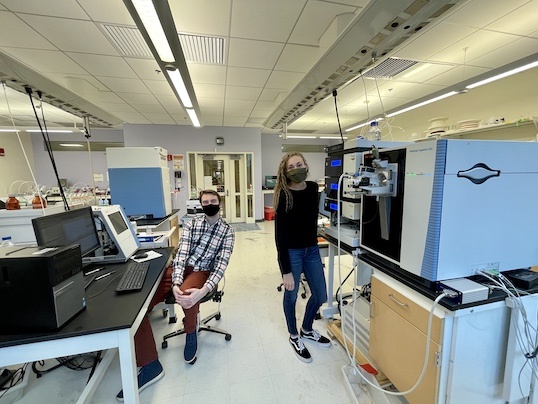
Lauren Stopfer and Cameron Flower take a break from their analysis to pose with their equipment, including the mass spectrometers.
Understanding which signaling pathways are active in cancer cells (and how active those pathways are) could help clinicians create more effective personalized cancer therapies for patients. Clinicians have tools that allow them to profile cancer cells for their genetic makeup or patterns of gene expression, but current methods for profiling signaling pathways are often too difficult, tedious, and error-prone to be used in the clinic.
Researchers in the White Lab have developed a new method, SureQuant pTyr, that allows for reliable and accurate measurement of one type of cell signaling activity, tyrosine phosphorylation. Often dysregulated in cancer, tyrosine phosphorylation is a process that initiates cell signaling cascades related to proliferation, programmed cell death, and survival. While there are therapies that target oncogenic enzymes that carry out tyrosine phosphorylation, there are no practical tools to predict how effective they will be in a patient.
The White Lab's method, which is both high-throughput and reproducible, represents a significant step towards bringing such tools to the clinic. SureQuant pTyr reliably identifies and quantifies several hundred several hundred tyrosine phosphorylation sites commonly implicated in cancer. In a study appearing in Cancer Research and funded in part by the MIT Center for Precision Cancer Medicine, researchers used SureQuant pTyr to profile human colon cancer tumors, identify activated signaling pathways, and highlight patient-specific drug targets. They hope that such an assay can soon be used for clinical decision making around targeted proteomics, in complement to existing genomic tools.